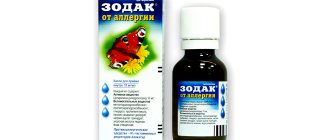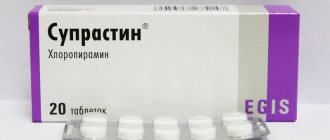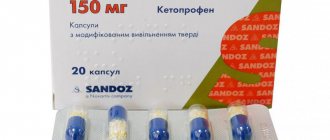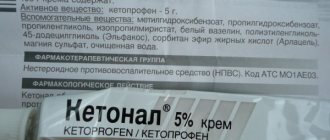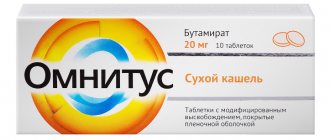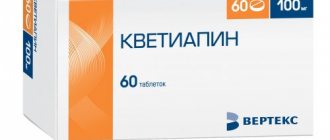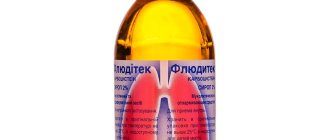Pharmacological properties of the drug Ketonal
Pharmacodynamics. Ketoprofen is an NSAID that has analgesic, anti-inflammatory and antipyretic effects. During inflammation, ketoprofen inhibits the synthesis of prostaglandins and leukotrienes, inhibiting the activity of cyclooxygenase and partially lipoxygenase; it also inhibits the synthesis of bradykinin and stabilizes lysosomal membranes. It has an analgesic effect and eliminates the manifestations of symptoms of inflammatory and degenerative diseases of the musculoskeletal system. Pharmacokinetics. When taken orally, ketoprofen is rapidly absorbed into the gastrointestinal tract. After oral administration (50 mg 4 times a day) with meals, the maximum concentration of ketoprofen in the blood plasma is reached after 1.5 hours and is 3.9 mcg/ml, whereas when taken on an empty stomach it is 2.0 mcg/ml and is achieved after 2 hours; for extended-release tablets, the maximum concentration in the blood plasma is achieved after 4–6 hours. The bioavailability of ketoprofen in oral forms is 90–93% and is directly proportional to the dose that is used. After rectal administration of 100 mg of ketoprofen, the maximum concentration in blood plasma (10.4 μg/ml) is determined after 1.05–1.22 hours. The bioavailability of ketoprofen is 71–96%. With intravenous infusion, the average level in blood plasma 5 minutes from the start and 4 minutes after completion of the administration is 26.4 ± 5.4 μg/ml. Bioavailability is 90%. The degree of protein binding is 99%. Volume of distribution - 0.1–0.2 l/kg. Ketoprofen penetrates into the synovial fluid. A stable concentration of ketoprofen in the blood plasma is achieved within 24 hours after taking oral forms. The pharmacokinetics of ketoprofen do not differ significantly depending on the age of the patients. Cumulation of ketoprofen in tissues is not observed. Ketoprofen is extensively metabolized in the liver via microsomal oxidation. It is excreted from the body in the form of a conjugate with glucuronic acid. The half-life is 2 hours. Up to 80% of the administered dose of ketoprofen is excreted in the urine, usually (over 90%) in the form of glucuronide, about 10% in feces. In patients with renal failure, the elimination of ketoprofen is slowed down, the half-life increases by 1 hour. In patients with liver failure, ketoprofen may accumulate in tissues. In elderly patients, the metabolism and excretion of ketoprofen is slow, but this is of clinical significance only in cases of impaired renal function.
Description
The drug "Ketonal" is a non-narcotic and non-hormonal drug, which is distinguished by powerful analgesic, anti-inflammatory and antipyretic properties. Due to this, it is used to relieve severe or moderate discomfort of various origins, for example, against the background of arthritis, spondylitis, osteoarthritis, radiculitis, myalgia, neuralgia, colic, menstruation, trauma and after surgery. Currently, it is one of the most popular drugs in its field, trusted by doctors and patients.
Use of the drug Ketonal
Ketonal capsules Doses are selected individually, depending on the patient’s condition and his response to treatment. The usual daily dose of ketoprofen is 100–300 mg, depending on the condition and nature of the disease. The maximum daily dose of ketoprofen is 300 mg. Ketonal capsules take 1 capsule 3 times a day. For rheumatoid arthritis and osteoarthritis, take 1 capsule every 6 hours. For pain during menstruation, the recommended dose is 1 capsule every 6–8 hours. Ketonal capsules can be taken with Ketonal suppositories according to the following scheme: 1 capsule in the morning and afternoon and 1 suppository in the evening. Capsules are taken during meals with water or milk (at least 100 ml). To prevent the negative effect of ketoprofen on the mucous membranes of the gastrointestinal tract, you can simultaneously take antacids. Ketonal Duo capsules The standard dose for adults and children over 15 years of age is 1 capsule (150 mg) per day. For short-term use, the maximum daily dose is 300 mg - 1 capsule every 12 hours. Capsules should be taken with food, swallowed whole and with plenty of water. They can also be washed down with milk or taken together with antacids to reduce the incidence of gastrointestinal disorders; milk and antacids do not affect the adsorption of the drug. The duration of treatment depends on the course and severity of the disease. Ketonal solution IM administration: the dose recommended for IM administration is 1 ampoule (100 mg) 1-2 times a day. The maximum daily dose of ketoprofen for intramuscular administration is 300 mg. If necessary, intramuscular administration can be supplemented with the administration of oral, rectal or transdermal forms of Ketonal. The daily dose of Ketonal can be increased to 300 mg or reduced to 100 mg, depending on the severity of the disease and the patient's condition. IV administration: ketoprofen infusions should be carried out only in a hospital setting. The infusion should be carried out over 0.5–1 hour, the course of treatment with intravenous administration should not exceed 48 hours. The maximum daily dose of ketoprofen for intravenous administration is 300 mg. Intermittent IV infusion: 100–200 mg of ketoprofen is diluted in 100 ml of sodium chloride solution (0.9%) for injection and administered over 0.5–1 hour; after 8 hours the infusion can be repeated. Continuous IV infusion: 100–200 mg of ketoprofen is diluted in 500 ml of infusion solution (sodium chloride solution 0.9% for injection, Ringer's solution with lactate, glucose solution) and administered over 8 hours ; after 8 hours the infusion can be repeated. Ketoprofen can be combined with narcotic analgesics; it can be mixed with morphine in one container: 10–20 mg of morphine and 100–200 mg of ketoprofen are diluted in 500 ml of infusion solution (sodium chloride solution 0.9% for injection, Ringer’s solution with lactate); after 8 hours the infusion can be repeated. The maximum daily dose of ketoprofen is 300 mg. Caution: do not mix tramadol and ketoprofen due to the formation of sediment. The bottle of solution for infusion should be wrapped in dark paper or aluminum foil, since ketoprofen is sensitive to light. Ketonal Retard tablets The recommended dose for adults and children over 15 years of age is 1 tablet once a day. To prevent unwanted effects, treatment should be short-term. The maximum daily dose is 200 mg. Ketonal Retard tablets should be taken after meals or during meals with a glass of water or milk. At the same time, you need to take antacids to reduce the side effects of ketoprofen on the gastrointestinal tract. Elderly patients. In elderly patients, the risk of adverse reactions increases. After 4 weeks from the start of treatment, monitoring for manifestations of gastrointestinal bleeding is necessary. Suppositories Ketonal Suppositories are inserted into the rectum, 1 suppository 1-2 times a day. Suppositories can be used in combination with other oral forms of Ketonal capsules or tablets according to the following scheme: 1 capsule (50 mg) in the morning and afternoon and 1 suppository (100 mg) in the evening; 1 forte tablet (100 mg) in the morning (in exceptional cases, you can take an additional 1 forte tablet in the afternoon) and 1 suppository (100 mg) in the evening. Doses are selected individually, depending on the patient’s condition and his response to treatment. The maximum daily dose of ketoprofen is 300 mg. To prevent the negative effect of ketoprofen on the mucous membranes of the gastrointestinal tract, you can simultaneously take antacids.
Release form and composition
Ketonal is produced in the form:
- Solution – colorless, transparent (in dark glass ampoules of 2 ml);
- Cream – uniform white (in tubes of 30 and 50 g);
- Gel – transparent, homogeneous, colorless (in aluminum tubes of 50 and 100 g);
- Suppositories – smooth, white, homogeneous (in strips of 6 pcs.);
- Capsules - opaque, with a blue cap and a white body, inside filled with compressed or loose white powder (in dark glass bottles of 25 pcs.);
- Film-coated tablets - round, light blue, biconvex (in dark glass bottles of 20 pcs.);
- Long-acting tablets - biconvex white round (in dark glass bottles of 20 pcs.).
Contents of the main active ingredient – ketoprofen:
- Ampoule with solution – 100 mg;
- 1 g of cream – 50 mg;
- 1 g of gel – 25 mg;
- Suppository – 100 mg;
- Capsule – 50 mg;
- Extended-release tablet – 150 mg;
- Film-coated tablet – 100 mg.
Auxiliary components:
- Solution – 0.8 g propylene glycol, 0.2 g ethanol, 40 mg benzyl alcohol, up to 2 ml water for injection;
- Cream – 0.5 mg propyl parahydroxybenzoate, 2 mg methyl parahydroxybenzoate, 50 mg isopropyl myristate, 320 mg white petrolatum, 70 mg propylene glycol, 90 mg propylene glycol glyceryl oleate, 30 mg elphacos ST9, 382.5 mg purified water, 5 mg magnesium sulfate;
- Gel – 37 mg trolamine (triethanolamine), 20 mg carbomer, 1 g water, 285 mg ethanol 96%, 0.28 mg lavender oil;
- Suppositories – 1.85 g of solid fat, 0.2 g of glyceryl caprylocaprate;
- Capsules – 186.1 mg of lactose, 2.4 mg of magnesium stearate, 1.5 mg of colloidal silicon dioxide;
- Film-coated tablets – 1.6 mg magnesium stearate, 1.2 mg colloidal silicon dioxide, 5 mg povidone, 44.2 mg corn starch, 8 mg talc, 60 mg lactose;
- Extended-release tablets - 3 mg magnesium stearate, 2 mg colloidal silicon dioxide, 7.5 mg povidone, 67.5 mg microcrystalline cellulose, 60 mg hypromellose.
Shell composition:
- Capsules – 0.94 mg of titanium dioxide, 0.17 mg of patent blue dye “Patent blue V”, up to 47 mg of gelatin;
- Tablets - 4.622 mg of hypromellose, 0.94 mg of macrogol 400, 0.153 mg of indigo carmine (E132), 1.054 mg of titanium dioxide, 0.281 mg of talc, 0.05 mg of carnauba wax.
Side effects of the drug Ketonal
As usual, transient. Most often, gastrointestinal disorders are observed (digestive disorders, dyspepsia, nausea, vomiting, constipation, diarrhea, heartburn, abdominal pain). Rarely - headache, dizziness, confusion, hypersomnia, drowsiness, swelling, mental changes, insomnia. In isolated cases, possible ulcerative stomatitis, ground, hematemesis, peptic ulcer, gastrointestinal hemorrhage or perforation, gastritis, duodenal and stomach ulcers. From the blood system: rarely - anemia, hemolysis, purpura, thrombocytopenia, agranulocytosis. High doses of ketoprofen can inhibit platelet aggregation, thereby prolonging bleeding time, and cause epistaxis and hematoma formation. From the immune system: asthma, bronchospasm or shortness of breath (especially in patients with hypersensitivity to acetylsalicylic acid and other NSAIDs); very rarely - angioedema and anaphylaxis. Mental disorders: common - depression, nervousness, nightmares, drowsiness; rarely - delirium with visual and auditory hallucinations, disorientation, dyslalia. From the side of the central nervous system: often - headache, asthenia, discomfort, increased fatigue, weakness, dizziness, paresthesia; very rarely - there have been isolated reports of cases of pseudotumor cerebri. From the organ of vision: often - visual impairment; very rarely - conjunctivitis. On the part of the hearing organ: common - tinnitus. From the cardiovascular system: often - edema; rarely - heart failure, hypertension (arterial hypertension). Clinical studies and epidemiological evidence suggest that a small increased risk of arterial thrombotic events (eg, myocardial infarction and stroke) may be associated with the use of some NSAIDs (especially at high doses and long-term use). There is insufficient data to exclude such a risk for ketoprofen. From the respiratory system: uncommon - hemoptysis, shortness of breath, pharyngitis, rhinitis, bronchospasm, laryngeal edema (signs of an anaphylactic reaction); rarely - asthma attacks. From the gastrointestinal tract: very - dyspepsia; often - nausea, abdominal pain, diarrhea, constipation, flatulence, anorexia, vomiting, stomatitis; very rarely - colitis, intestinal perforation (as complications of diverticula), exacerbation of ulcerative colitis or Crohn's disease, enteropathy with perforation, stenosis. Enteropathy may be accompanied by mild bleeding with loss of protein. There have been case reports of rectal perforation in elderly women. Peptic ulcers, perforation or gastrointestinal bleeding may occur, sometimes fatal, especially in elderly patients. Ulceration, hemorrhage or perforation may develop in 1% of patients after 3–6 months of treatment or in 2–4% of patients after 1 year of treatment with NSAIDs. Melena, bloody vomiting, and exacerbations of ulcerative colitis or Crohn's disease have been reported after use. Gastritis was rarely observed. From the hepatobiliary system: very rarely - severe liver dysfunction, which is accompanied by jaundice and hepatitis. Skin disorders: common - skin rash; in isolated cases - alopecia, eczema, purple-like rash, increased sweating, urticaria, exfoliative dermatitis; rarely – photosensitivity, photodermatitis; very rarely - bullous reactions, including Stevens-Johnson syndrome and toxic epidermal necrolysis. From the urinary system: very rarely - acute renal failure, interstitial nephritis, nephrotic syndrome, acute pyelonephritis. From the reproductive system: very rarely - menometrorrhagia. Laboratory indicators: very often - deviation from the norm in liver function tests; rarely - during treatment with NSAIDs, ALT and AST levels increase significantly. Ketoprofen reduces platelet aggregation, thereby prolonging bleeding time.
Contraindications
We have reviewed the indications for the use of Ketonal tablets. Restrictions on the use of the medicine in question are the following conditions:
- The presence of hypersensitivity to ketoprofen or to the auxiliary ingredients of the drug - to salicylic or tiaprofenic acid, as well as to other medications in the category of anti-inflammatory non-steroidal drugs, to Fenofibrate, fragrances and UV blockers.
- Against the background of clinical episodes of bronchial asthma attacks immediately after the prescription of anti-inflammatory non-steroidal drugs and salicylic acid derivatives.
- During pregnancy from the twenty-eighth to the forty-second week. In the first two periods, the prescription of this medicine is quite acceptable, but only if the expected effect for the woman is higher than the danger to the fetus.
- In childhood up to fifteen years.
- Damaged areas of the skin in the form of an open wound, eczema, weeping dermatitis.
- For skin hypersensitivity to ultraviolet rays.
- In case of exposure to the sun, including indirect radiation, as well as dosed ultraviolet irradiation in a solarium.
Special instructions for the use of the drug Ketonal
When prescribing Ketonal for systemic use, caution should be exercised in patients with a history of gastric or duodenal ulcers or gastrointestinal bleeding. Perforation or gastrointestinal bleeding may occur without the development of previous symptoms. Caution is recommended in patients with impaired liver or kidney function, as well as in patients taking coumarin anticoagulants. The drug is not recommended for use in porphyria. If renal function is impaired, dose adjustment is necessary. Ketoprofen may worsen the course of hypertension (arterial hypertension) and increase the risk of developing peripheral edema. Ketoprofen should be prescribed with caution to elderly people due to the increased risk of side effects. As with the treatment of other NSAIDs, with long-term use of ketoprofen it is necessary to monitor the composition of peripheral blood, liver and kidney function, especially in the elderly. Like other NSAIDs, ketoprofen may mask symptoms and signs of infectious diseases. Smoking and drinking alcohol are not recommended during treatment with Ketonal. The safety of using ketoprofen during pregnancy and lactation has not been established. Ketoprofen can be used in the first and second trimesters of pregnancy only if the expected therapeutic effect for the expectant mother exceeds the potential risk to the fetus. NSAIDs are not recommended for use during pregnancy beyond 36 weeks. When treating with Ketonal, you must stop breastfeeding. The drug does not affect the ability to drive vehicles or operate potentially dangerous machinery. However, in rare cases, NSAIDs may cause dizziness or drowsiness. In this case, you should refuse to manage such funds.
Therapeutic efficacy
As the instructions for use for Ketonal tablets indicate, the therapeutic activity of this medication is associated with its active substance - ketoprofen, it is classified as a non-steroidal anti-inflammatory drug with three special effects: analgesic, anti-inflammatory and antipyretic. But it is worth noting that it has the most pronounced analgesic and anti-inflammatory effect, and the antipyretic effect is somewhat weaker. In this regard, the medicine is used as a drug that helps with pain syndromes of various origins.
All the properties of the described product are ensured due to the ability of the active ingredient to block the enzymes cyclooxygenase and lipoxygenase, due to this, the production of prostaglandins, which provoke the development and support inflammatory reactions, stops (it is they that cause the pain impulse with an increase in temperature).
Thus, the drug “Ketonal” blocks the formation of substances that cause inflammation, pain and temperature. A distinctive feature of the drug is its wide range of analgesic effects, which consists of influencing the central and peripheral nerve fibers responsible for the perception of various impulses. It is because of this that it is considered a highly effective drug in the presence of discomfort in various areas of peripheral tissue and organs, as well as in joints, ligaments, muscles, veins, blood vessels, and so on. By reducing inflammatory reactions, the medication relieves pain and reduces morning stiffness along with swelling, and increases range of motion. Next, we will find out in what cases it is advisable to take this medicine.
Interactions of the drug Ketonal
Ketoprofen, when used systemically, increases the effectiveness of oral hypoglycemic and some antiepileptic drugs, reduces the effectiveness of diuretics and antihypertensive drugs. The simultaneous use of diuretics and NSAIDs increases the risk of developing renal failure. The use of Ketonal with ACE inhibitors increases the risk of nephrotoxicity. Patients taking ketoprofen in combination with warfarin and corticosteroids require regular medical monitoring due to the possibility of bleeding. Treatment of patients with ketoprofen simultaneously with lithium should be carried out under close medical supervision, since the toxicity of lithium increases. When ketoprofen is taken simultaneously with methotrexate and cyclosporine, the toxicity of the latter may increase. Ketoprofen should not be taken in combination with salicylates and other NSAIDs.
Overdose
As the instructions for use indicate, the drug "Ketonal" in tablets can cause an overdose in patients, manifested by symptoms such as nausea, vomiting (including blood), abdominal pain, melena (black stool), impaired consciousness, respiratory depression, convulsions and failure of the kidneys up to the failure of this organ. To eliminate an overdose, first of all, you need to try to remove the remaining drug from the body.
To do this, gastric lavage is performed along with taking sorbents in the form of activated carbon, Polyphepan, Polysorb and others. After this, symptomatic therapy is carried out aimed at supporting the normal functioning of important systems. It is advisable to use histamine blockers, for example, Suprastin along with Erius, Claritin, Telfast. Proton pump inhibitors like Lansoprazole, Omeprazole, Rabenprazole, Esomeprazole, and so on are also suitable.
Reviews
Judging by the large number of comments about Ketonal, people often use tablets of this drug to relieve pain. It is worth noting that most of these messages are positive. For example, they talk about the high effectiveness of the drug, reliable relief of pain of various localizations and elimination of its cause. Among other things, it is noted for its long-lasting effect and ease of use.
But people who leave positive reviews about this product, in addition to the advantages, also point out some disadvantages, which they attribute to the high cost. Some complain about the relatively slow onset of pain-relieving properties. But, nevertheless, such disadvantages cannot overshadow the high effectiveness of the drug in question.
It is also important to note that many negative reviews about the drug “Ketonal” are mainly associated with the occurrence of certain side effects or with the prolonged development of the analgesic effect, against which it was necessary to wait a long time before the pain was completely relieved and use the drug for three days. Otherwise, it is reported that it helps well, but it should be used only with the permission of a doctor and strictly in accordance with the instructions for use. We have explained why Ketonal tablets are prescribed.
Analogs
Synonyms for tablets are the following pharmaceuticals:
- Capsules "Artrosilene".
- The drug "Artrum" in tablets.
- "Bystrumcaps" in capsules.
- "Ketoprofen" tablets.
- Flamax forte pills.
Next, let’s get acquainted with the opinions of consumers and find out what they say about these tablets on the Internet.

